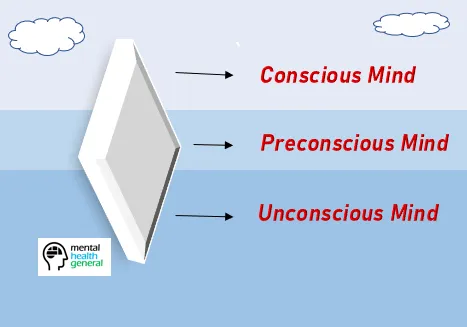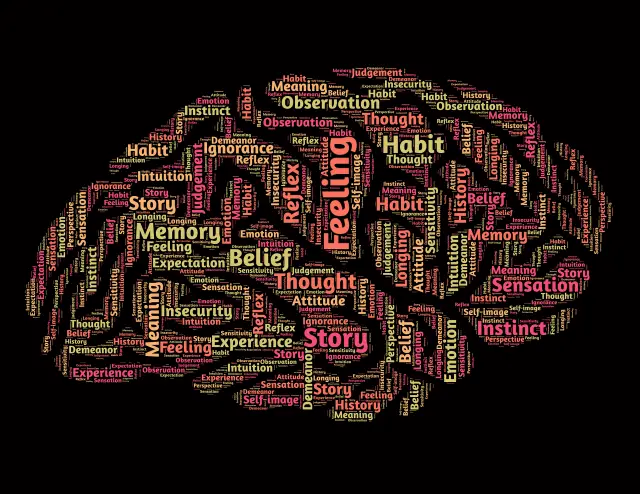The Unconscious Mind is the part of the mind that repressed thoughts, feelings and memories are located.
The various processes that go on in the unconscious mind are not available to the conscious mind – and therefore a person isn’t acutely aware of them. Despite this, multiple theories suggest that these repressed feelings have an impact on a person’s behaviour in the current day – usually in a negative way.

Background
Sigmund Freud is credited for popularising the theory of the unconscious mind – which Freud theorises is one of three parts of the mind. The other two parts are called the preconscious and the conscious mind.
Freud suggested that certain thoughts, feelings and memories are located in the unconscious mind. These areas normally relate to traumatic experiences, and therefore as a defence mechanism – the mind has neglected to process them, causing them to be in the unconscious mind.
We have an article that provides an overview and explores the differences of these three levels of the mind, as well as looking at how areas in the unconscious mind can reach the conscious mind.
Freud’s Mind Analogy
Freud used an iceberg to explain his theory of the mind. When a person sees an iceberg, they can only see what is above the water, and are therefore unaware of what is under the water.
Freud argues that this is like the human mind. A person can only see a small amount, the rest lies underwater. The tip of the iceberg refers to the conscious mind, with the remainder of the iceberg out of view under the water – which refers to the unconscious mind.
One is never truly aware of how much of the iceberg is out of view – the unconscious mind may be very, very deep.
The other area is the middle-ground of the two – and known as the preconscious. It is the part of the iceberg that is mainly submerged below the water, yet still visible from above.

The impact of the unconscious mind
Because certain traumatic experiences are located in the unconscious mind, Freud suggested that they would have an effect on the behaviour of a person – even if they weren’t aware of it.
Freud went on to state that psychological problems – such as mental health issues – were often caused by these experiences being blocked out – something called “Repression“.
The suggestion is then that a person can be treated through talk therapy, where a gradual process takes place that aims to help an individual locate these feelings, and process them in a healthy way.
There are many techniques that can be employed to achieve this. This is closely related to Freud’s theory of Psychoanalysis.
Many talking treatments use elements of Psychoanalysis in treating mental health issues to this day – with Psychoanalytical Psychotherapy the most well-renowned.
Freud’s theory on basic instincts (called Life and Death instincts) also relate to the unconscious mind. He argued that these instincts are present in the unconscious mind.
Life instincts is based on survival, while death instincts refer top thoughts of anger and aggression that are directed externally. Any such urges are withheld from the conscious mind as they are seen as unacceptable.
In order for this process to take place, and for the negative urges to be kept out, humans employ Defence Mechanisms. Moreover, there are many examples of defence mechanisms.
Carl Jung’s Theory on the Unconscious Mind
Freud was far from the only psychologist to discuss the unconscious mind, and the impact it has. In fact, Carl Jung – another highly-revered psychologist – was able to build on Freud’s work to create his own theory.
Jung believed that the Unconscious mind was made up of two areas – the personal unconscious and the collective unconscious.
Jung believed that the personal unconscious referred to areas that were once conscious but had since been supressed.
Meanwhile, Jung suggested that the collective unconscious referred to the deepest part of the psyche – and contained elements that revolve around the collective knowledge of humanity, an area which is inherited.
Jung suggested that every person in the world has the same collective unconscious. Conversely, personal unconscious was unique to each person.
Other theories on the Unconscious mind
There have been many suggestions however that the unconscious mind doesn’t exist. Several psychologists in recent decades have sought to come up with different theories to explain what Freud and Jung attributed to the unconscious.
The validity of Freud and Jung’s theory wasn’t helped in the 1970s, when hypnosis was frequently used to try and reach the unconscious mind – something that often resulted in false memories, incorrect incarceration, and lawsuits.
The idea of the unconscious mind and the mind in general is something that continues to result in significant debate and discussion.
Summary
The Unconscious mind is certainly an intriguing idea. There is a lack of consensus on its exact nature – which is what makes it such an interesting topic.
The Unconscious mind still features heavily in some types of talking therapy. In others, it is somewhat obsolete, but its impact is felt.
See Also
- Overview of Sigmund Freud’s Theories
- Freud’s Theory of the Unconscious, Conscious and Preconscious Minds in Mental Health
- What is the Unconscious Mind in Mental Health?
- What is the Preconscious Mind in Mental Health?
- What is the Conscious Mind in Mental Health?
- What is the Difference Between The Unconscious and Conscious Mind in Mental Health?
- How Can You Reach the Unconscious Mind in Mental Health Therapy?
- Homepage
Disclaimer
This website should be used purely for informational purposes, and does not intend to, nor should it ever, be used as a replacement for professional medical advice.
We strive to keep all of our pages updated, and ensure that our website is full of factual and in-depth information. However, we encourage you to browse this website with care.
As a reminder, this website and all content within it cannot and should not replace the advice of a trained medical professional. You can read our full disclaimer at this link.
Helplines
If you are struggling with your mental health, help is available. With the right support and treatment, you can make a recovery. For information on helplines, or if you are in a state of crisis, please visit our crisis page by clicking on the relevant link for your geographical location (United Kingdom), (United States), (International). You can also see how to get mental health treatment and the process involved by clicking this link.


































